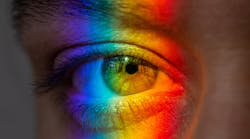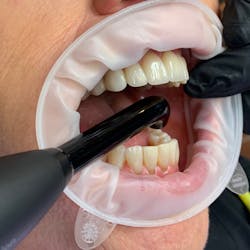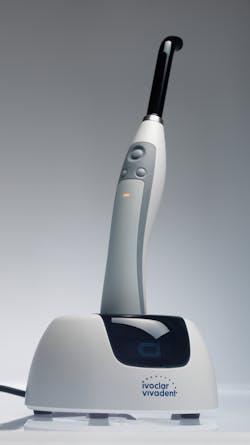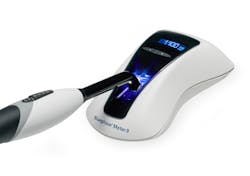Now, more than ever, dental professionals need to focus on long-term eye health and reevaluate the personal protective equipment (PPE) we use for ourselves and our patients. Since last year, I have been researching the long-term effects on dental professionals’ eyes from all of the new visual technology that includes overhead lights, additional loupe lights, lasers, curing lights, lighted handpieces, and ultrasonic tips.
How can we create an environment that does not reflect these light sources back into the clinician’s eyes? The retina in the eye focuses on the brightness or radiance of lights. Filtration, diffusing brightness of light sources, proper protection, and creating a nonreflective environment can all help to reduce the risk of long-term eye injury for dental professionals.
To create a nonreflective environment, start by using matte-finish innovative products: black nonreflective gloves (e.g., CranberryEye protection and new technology that protect the eyes of both clinicians and patients from electromagnetic radiation caused by lasers and ultraviolet (UV) rays from the blue light of curing lights are now available. It is critical that all dental professionals and patients adhere to laser eye protection for the duration of the procedure. Check laser and curing light manufacturers’ guidelines for recommendations regarding eye protection.
The average dental office completes 1,000 light-cured restorations with multiple cures annually. Chronic exposure to blue light has been linked to color distortion, eye strain, headaches, retinal aging, and age-related macular degeneration.1 Clinicians with as few as seven light exposures to blue light from a curing light or reflection in a workday could cause irreversible damage to the retina and cumulative negative effects.
Curing lights are an essential technology to cure many different types of dental materials: sealants, bases, restorations, orthodonticGenerally, curing lights are between 500 and 1,200 mW/cm2 and have a service life of five years. Do you know what light intensity your curing light emits? It may be time to upgrade to a higher intensity light, which will cure faster, create less exposure time for the eyes, and yield a more predictable and quality dental material (e.g., Bluephase G4 by Ivoclar Vivadent; figure 2).
The Bluephase G4 curing light is an example of smart technology that alerts clinicians when they are moving away from the tooth surface. A built-in radiometer ensures efficiency and effectiveness. The removable, nonreflective black probe is autoclavable, and the sealed handle makes infection control easier. A separate stand-alone radiometer can also be used tocheck a curing light’s intensity (figure 3). Always perform a daily radiometer test that checks the light intensity emitted by your curing light for that day. Curing lights can vary up to 20% or more. Be sure to disinfect the curing light after each patient as well.
There are other eye hazards in offices for dental professionals and patients to be aware of: ocular contusions or trauma from blunt or sharp objects and conjunctivitis, in which inflammation can be linked to waterline contaminants and can also include herpes simplex. Viral and bacterial contamination from the aerosol spray of handpieces, ultrasonics, and air-polishing units can stay in the air for 30 minutes, and spatter from the patient’s mouth can transfer into their eyes or the clinician’s.2 Currently, 96% of dental professionals protect their eyes by wearing safety glasses, loupes, or prescription glasses, but only about 50% of dental offices provide eyewear for their patients—even though it has been a Centers for Disease Control and Prevention (CDC) guideline since 2003.3,4
What is the best solution for eyewear that the patient and the clinician can use to protect themselves against UV rays and other eye hazards? Many doctors use loupes with a built-in UV filter, which is effective and convenient. Anyone who does not have loupes with a built-in filter—the patient, the dental professional who assists the doctor, or the hygienist—needs tinted antiglare goggles that absorb light below a wavelength of 500 nm (e.g., protective orange goggles or the equivalent that filter out blue light emissions).2
Prolonged exposure to reflective surfaces and instruments can cause eye injury, especially without nonreflective eye protection. All dental professionals and patients should be wearing eye protection for any dental procedure, including safety glasses, goggles, prescription glasses with side shields, or full-face safety shields to protect the mucus membranes of the eyes, nose, and mouth from aerosols and spatter.4
Take PPE to another level with eye protection by creating a nonreflective environment that protects both you and your patient. Diffuse all light sources and add nonreflecting gloves and glare-reducing instruments to reduce the risk of long-term injury to the eyes. Consider upgrading your curing lights and test them daily to make sure you are curing dental materials efficiently and properly. The time is now to choose to protect your eyes and those of your patients for long-term health.
References
- Alasiri RA, Algarni HA, Alasiri RA. Ocular hazards of curing light units used in dental practice—a systematic review. J Saudi Dent. 2019;31(2):173-180. doi:10.1016/j.sdentj.2019.02.031
- Ekmekcioglu H, Unur M. Eye-related trauma and infection in dentistry. J Istanb Univ Fac Dent. 2017;51(3):55-63.
- Farrier SL, Farrier JN, Gilmour ASM. Eye safety in operative dentistry - a study in general dental practice. Br Dent J. 2006;200(4):218-223. doi:10.1038/sj.bdj.4813257
- Kohn WG, Collins AS, Cleveland JL, et al. Guidelines for infection control in dental health-care settings—2003. MMWR Recomm Rep. 2003;52(RR-17):1-61. https://www.cdc.gov/mmwr/preview/mmwrhtml/rr5217a1.htm
SUSAN WINGROVE, BS, RDH, is a dynamic innovator, international speaker, writer, researcher, instrument designer, and RDH Award of Distinction recipient. She is a published author for Dental Economics, Digital Dentistry & Healthcare Knowledge, RDH magazine, Scientific Panel for ACP Clinical Practice Guidelines, Doctor Clinical Implant Maintenance White Papers, Dynamic Concepts blog, and an implant maintenance textbook—Peri-Implant Therapy for the Dental Hygienist—available from Wiley/Blackwell. Wingrove resides in Missoula, Montana. You may contact her at [email protected] or visit wingrovedynamics.com.











